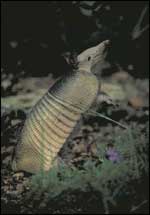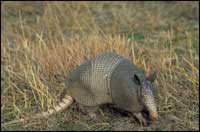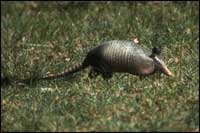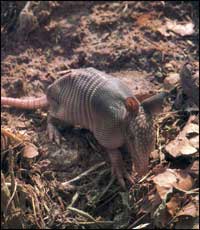Armadillos
Armadillo-mania is contagious in the Lone Star State, as Texans, for no apparent reason, have adopted this armor-plated critter as their mascot. Affection for the near-sighted rooter has reached the faddish level as decals, games, puzzles, candles, stuffed toys, figurines, jewelry, T-shirts, and other items are decorated with or shaped to resemble armadillos.
And what about the creature that has caused this strange cult of armadillo lovers – a less likely mammal could hardly be found. It isn't even cuddly. Some observers, who have not fallen under the armadillo's spell, have been so unkind as to call it ugly.

A feeding armadillo sensing danger may stand up on its hind legs and appear to look around, but its eyesight is quite poor and it is actually sniffing the air for enemies.
The nine-banded armadillo belongs to a primitive order of mammals called Endentata, which means "toothless." However, this name is misleading where the armadillo is concerned. Although it lacks incisor and canine teeth, it does have twenty-eight to thirty-two peglike molars set well back in its jaws. Since the seven or eight teeth lining each side of the upper and lower jaws are not visible unless the mouth is fully opened, it is easy to see why the animal was thought to be toothless.
Further classification of the nine-banded armadillo places it in the sub-order Xenarthra, which apparently developed in South America. Anteaters, sloths, and armadillos make up the three families within this sub-order and, with the exception of the nine-banded armadillo, all other members are restricted to Central and South America.
Traveling up from South America, the nine-banded armadillo entered Texas from Mexico a little more than a century ago. Its Texas range in the 1870s was restricted to the Lower Rio Grande Valley, but twenty years later it could be found as far north as Austin. It continued to extend its range northward and eastward, finding living conditions in Louisiana to its liking. By the 1930s it had moved into Oklahoma and increased its population in Texas.
If it were not for cold weather, this South American immigrant still might be traveling northward. However, a moderate climate is essential for its survival since the armadillo does not hibernate and cannot endure long periods of freezing weather. The armorlike shell that covers most of its well-muscled body provides a certain amount of protection, but it offers little insulation against the cold.
The body shell is divided into three main parts. The front part protects the shoulders and provides an area into which the head can be partially retracted. The back part protects the pelvic region, and the middle – which consists of nine, flexible, somewhat-telescoping bands – connects the other two parts.

During its continuous search for food, the armadillo wanders around in a rambling, unhurried manner. Often its head is buried in vegetation as it roots along the ground.
Heavy scales cover the armadillo's head and the exposed surfaces of its legs, but the underparts of its body have nothing to protect them except tough skin and a bit of coarse hair. This means the creature, when caught, has little defense against dogs, coyotes, mountain lions, and other such predators. For this reason, the shell's smooth surface may be more important to survival than its armorlike qualities. It allows the armadillo to run through heavy brush and brambles and escape a predator that cannot go through thorny underbrush as quickly.
Useful though it may be on most occasions, the heavy shell is a definite handicap around water. If an armadillo is tossed into deep water, it sinks, then comes to the surface and swims with an awkward dog-paddle stroke. Its heavy body remains almost completely submerged, and the animal tires rapidly. To increase buoyancy and help offset the shell's weight, the armadillo gulps air, inflating its stomach and intestines to double their normal size. This creates a built-in life preserver. When the swim is over, it may take as long as three hours to get rid of the swallowed air.
Armadillos have been seen crossing narrow streams and roadside ditches by walking on the bottom instead of swimming, but how often this happens is debatable. Some believe it is uncommon, while others think such short crossings happen frequently in the animal's familiar home territory.
To test the armadillo's ability to navigate underwater, some researchers conducted an experiment with a pool of water eight feet wide. The water level, which was about six inches deep for the first six feet, increased to twelve inches for the last two feet. An armadillo released at the edge readily entered the water and walked across the pool. During the experiment, it was forced to make ten round-trip crossings. Each time, whether entering from the shallow or deeper side, it walked instead of swimming. It was completely submerged in the twelve-inch water, but the top of its shell was exposed in the shallower water. An interesting thing happened during the experiment. Although the armadillo did not do so in the beginning, on later crossings it held its muzzle above the surface when walking through the shallow water.
An armadillo usually is found close to some source of water. Even though the moisture content of its food is high, it still requires drinking water, which it laps like a dog. It also enjoys a cooling wallow in the mud like a pig.
On cloudy or rainy days when temperatures are warm, the armadillo roots around in search of food throughout the daylight hours. Woodlands provide shady grubbing areas on clear, hot days, but when the temperature gets too high, the armadillo heads for the cooler comfort of its burrow and waits for twilight and the night hours for foraging. Winter is just the reverse. The armadillo goes out to feed only during the day when the winter sun provides some warmth. Burrows provide some protection from bad weather, but time spent below ground is limited by the armadillo's need to forage daily.

While feeding, the armadillo digs cone-shaped pits about three or four inches deep, laps up any exposed insects before moving on, then revisits the pits regularly to claim any insects they may have trapped.
The armadillo's twelve- to seventeen-pound body requires a lot of food, so the time spent above ground is occupied by searching for food. It would be rare indeed to find an undisturbed armadillo that was not foraging.
Normally the armadillo wanders about in a rambling, unhurried manner. If left alone, it travels no more than one-third mile per hour, but when danger threatens, it can turn on the speed and is a master at dodging. Unlike some of its South American relatives, the nine-banded armadillo does not roll into a tight ball for protection. Unless injured or exhausted, it runs when frightened.
During its continuous and dedicated search for food, the armadillo seems unaware of its surroundings. Its tiny eyes may be partially closed or half buried in vegetation as it roots along. Even when the eyes are exposed, its eyesight can only be considered poor. A feeding armadillo, sensing danger, may stand up on its hind legs, bracing itself with its tail, and appear to look around while sniffing the air for enemies. However, it can look directly at someone who is standing still and give no indication that it sees anything. If the person remains motionless and makes no noise, and if the human scent does not reach the armadillo, the creature probably will resume feeding.
If startled, an armadillo may respond by leaping straight up before running. One observer, who pitched small rocks one at a time at a feeding armadillo, reported that the animal leaped into the air after each rock landed, then stood up and sniffed the air for danger. Feeding activity resumed shortly after each jump when no enemy was scented or seen. After several rocks had landed nearby, the fact that the disturbances might mean danger finally seemed to penetrate its brain, and it took off at high speed.
This nervous jumping response probably is responsible for many of the road-killed armadillos. Even when the motorist is able to straddle the animal with the vehicle's wheels, the upward leap brings the armadillo's body into contact with the car's understructure, breaking the shell and causing fatal injuries.
Armadillos cannot be considered stealthy animals by any stretch of the imagination. Many a hunter has been disappointed when the herd of deer he thought was heading for his stand turned out to be a snuffling, shuffling armadillo rooting its way through leaves and other woodland debris. As if that weren't noisy enough, the armadillo also may make low grunting sounds as it digs for food.

A baby armadillo has a soft leathery shell that does not harden until it grows to adult size.
A keen sense of smell enables the near-sighted armadillo to locate grubs, beetles, insects, snails, worms, ants, and other such gourmet delights that may be buried beneath six inches of soil. Its long, sharp claws – four on the front feet and five on the rear ones – can dig even the most elusive tidbit out of the soil or rotten wood; and its finely barbed, sticky tongue is perfect for picking them up.
Although it also eats berries and some other vegetation, its rooting and digging for insects are what bring the armadillo into conflict with humans. Few people looking at damaged lawns, flowerbeds, and gardens are consoled by the fact that the armadillo causing the damage was only searching for bugs – grubs that may be harmful to those same lawns, flowers, and gardens, but not in such an obvious way.
While feeding, the armadillo digs cone-shaped pits, usually no more than three or four inches deep. It laps up any insects it finds in the soil before it moves on in search of other places to dig. These pits may become traps for other insects, and the armadillo revisits them regularly. When the armadillo finds an anthill or termite nest, digging gets underway in earnest. The tongue picks up the ants or termites as quickly as they are exposed and the feeding armadillo may end up with its head, shoulders, and sometimes entire body underground. A large, unsightly hole results.
In addition to digging for food, an armadillo's claws are used to dig burrows. In limestone areas the armadillo must rely on natural cavities in the rocks to provide shelter, but numerous burrows are found in the sandy loams of East Texas and other areas where digging is relatively easy. One armadillo may have as many as fifteen burrows located in its ten-acre range – some in use and some abandoned.
Most of these burrows are seven to eight inches in diameter and two to twenty-five feet long. They usually are fairly straight, but bends and turns occur when the digger meets with an underground obstacle. A burrow dug around a network of tree roots can end up with some complex tunnels. Burrows serving as permanent residences may have several passages with openings above ground, but usually only one entrance is used regularly. The others provide emergency access. Oftentimes blackberry brambles or other heavy vegetation help conceal the entrances.
Abandoned burrows often become homes for opossums, rabbits, skunks, rodents, burrowing owls, snakes, spiders, and other such creatures. For this reason, it is unwise to reach into any burrow trying to find an armadillo at home.
Except during the breeding season and when the young are small, the armadillo is a solitary creature and will live all alone in its burrow system. Breeding burrows contain a nest area that is filled with a bushel or so of leaves and grass. The vegetation is stuffed loosely into a dome-shaped chamber and the armadillo merely pushes its way in and out each time the nest is used. The nest cavity, usually located at the far end of a tunnel, is about eighteen inches in diameter and may be as much as three feet underground.
According to William B. Davis in his book The Mammals of Texas, breeding takes place from September to December, with the older females breeding first and the younger ones later. The young are born in March and April. The female has four mammary glands – two on the upper chest and two on the lower abdomen – just the right number for the quadruplets that are born each time. The four young, always of the same sex, come from a single fertilized egg. The embryo starts as a single individual; however, through a process of bisection, followed by a second sub-division, four clonelike embryos are formed. Each is enclosed in its own membrane sac.
The young are born with their eyes open and are able to get around within a few hours. With the exception of their soft, leathery shells, the young are miniature copies of the adults. Since the shell cannot be shed and replaced with a larger one, it must increase in size as the young armadillo grows, and it does not harden until adult size is reached.
Insect-hunting trips with the mother start before weaning, which takes place at about two months of age. The young remain with the mother until the start of the next breeding season. They then go out on their own. Sexual maturity occurs in the second year.
Because same-sex quadruplets normally are born, the docile armadillo is an ideal laboratory animal for various types of medical research. The genetically identical young provide built-in controls. The armadillo has been especially valuable for leprosy research since it is the only known mammal, other than humans, that can be infected with this disfiguring disease. Hopefully, through this research, the armadillo will provide the key to a cure for human leprosy.
Several armadillos captured in the wild in southern Louisiana and East Texas were found to have mycobacterial leprosy. Those people who eat armadillo meat will find that thorough cooking should make the meat noninfectious. However, the greatest hazard of being infected (if any) may be encountered during cleaning and dressing of the animals.
In the interest of health, a law was passed in Texas prohibiting the sale of live armadillos. (The same law also makes it illegal to sell skunks, an animal known to transmit rabies.) The purpose of the law is commendable, but thanks to the current armadillo-mania, prohibiting the sale of live armadillos has not lessened human contact with the armor-plated critters. They still are being caught for armadillo races; their shells are being converted into hard hats and other weird curios; whole animals are being stuffed in such undignified positions as lying on their backs, supposedly guzzling beer from a bottle; and the meat is being baked, barbecued, or turned into chili.
Eating armadillos is not widespread in Texas today, although it has been popular among south-of-the-border residents for more than a hundred years. Many Texans, especially during the depression years of the 1930s, dined on the "Hoover Hog," referring to the armadillo as "poor man's pork."
Probably one of the reasons people do not eat more armadillo is the animal's strong odor. This smell comes from glands located close to the anus. One-fourth inch in diameter and three-eighths inch long, these glands are present in both sexes and unnoticeable unless protruded and functioning. The scent, present at all times, increases when the animal gets excited or struggles. Older males fairly reek, and few people who butcher one can stand to eat the meat.
Whatever your opinion of the armadillo, whether you are one of its lovers or haters, you must agree that it is truly unique – a determined immigrant that has made itself a Texan.
Ilo
Hiller
1990 – Armadillos: Introducing Mammals to Young
Naturalists. The Louise
Lindsey Merrick Texas Environment
Series, No. 10, pp. 72-78.
Texas A&M University
Press, College Station.